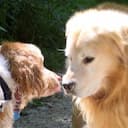Origins and Temperament
The Border Terrier, a breed hailing from the border country between England and Scotland, was originally bred to hunt foxes and control vermin. This background has endowed them with a determined and hardy temperament. Despite their bold natures, they are known to be affectionate, trainable, and eager to please, making them excellent companions. Their travel needs may include staying mentally stimulated and physically active. Because of their strong prey drive, it's imperative to ensure that a Border Terrier remains secure and cannot chase after wildlife during stops.
Size and Physical Needs
Border Terriers are small, agile dogs, typically weighing between 11.5 to 15.5 pounds. While modest in size, they possess a robust constitution and require regular exercise to maintain their fitness. During transportation, it's important to provide a safe, comfortable space where they won’t feel cramped, along with opportunities for regular physical activity to satisfy their zest for life.
Common Health Considerations
Border Terriers are generally healthy, but like all breeds, they're prone to certain health conditions such as hip dysplasia, heart defects, and seizures. It's crucial to have up-to-date health documentation during travel to handle any emergencies that may arise. Preventative measures, including familiarity with their medical history and any medications they require, are key for a safe trip.
















